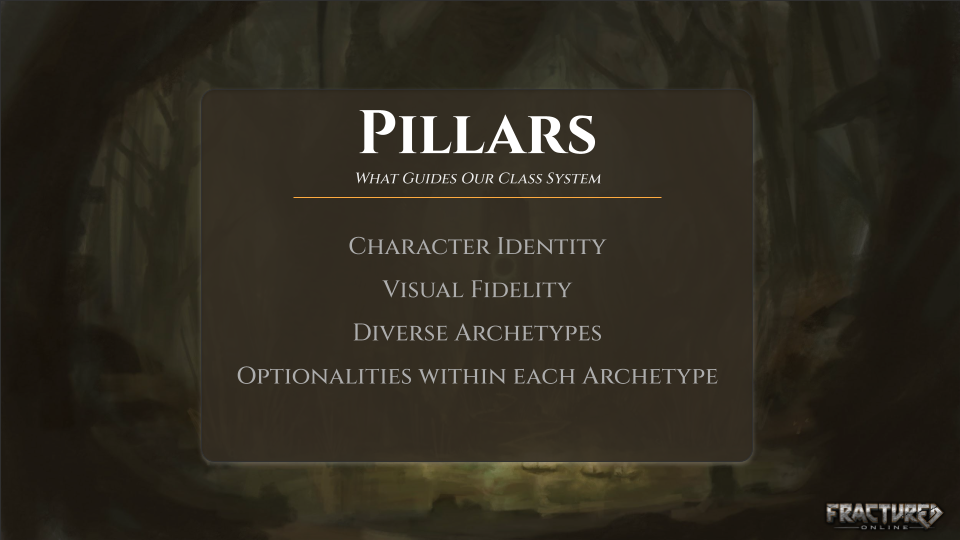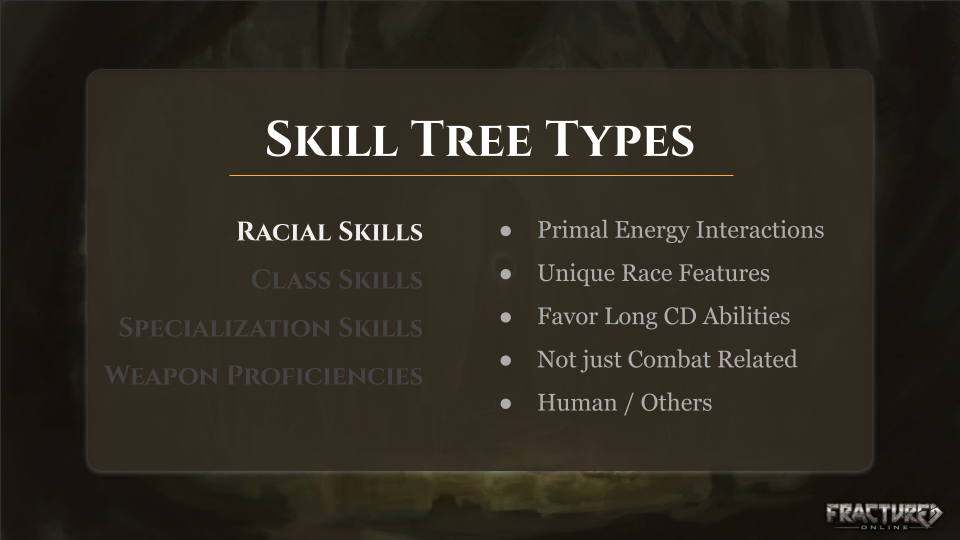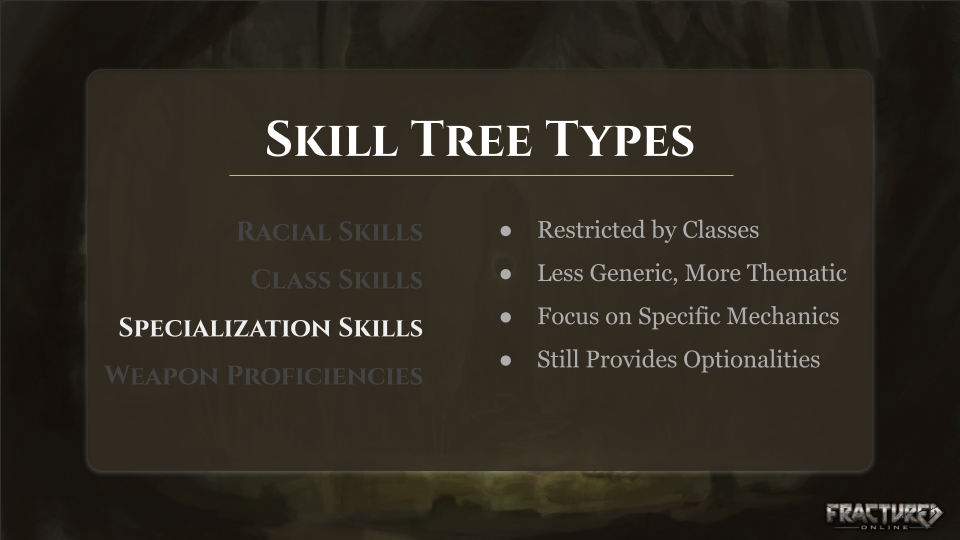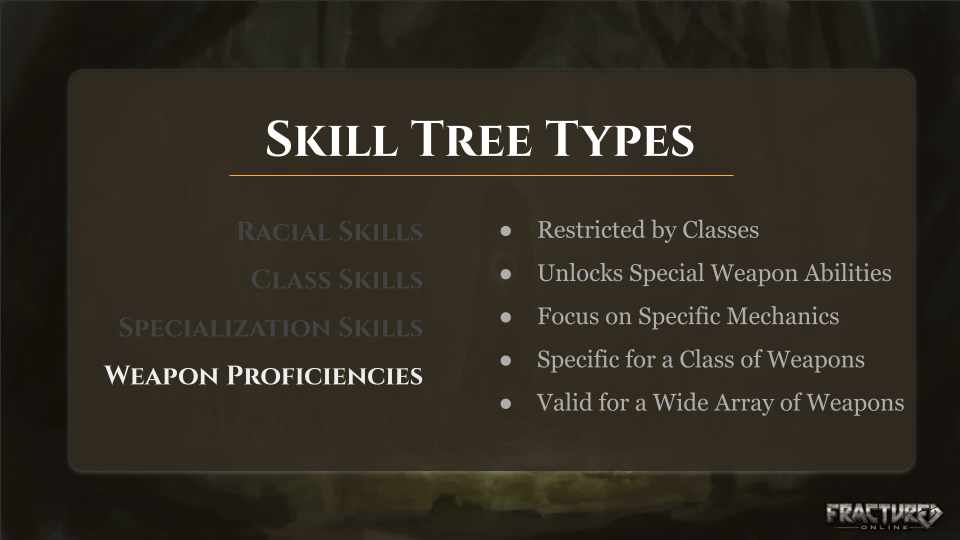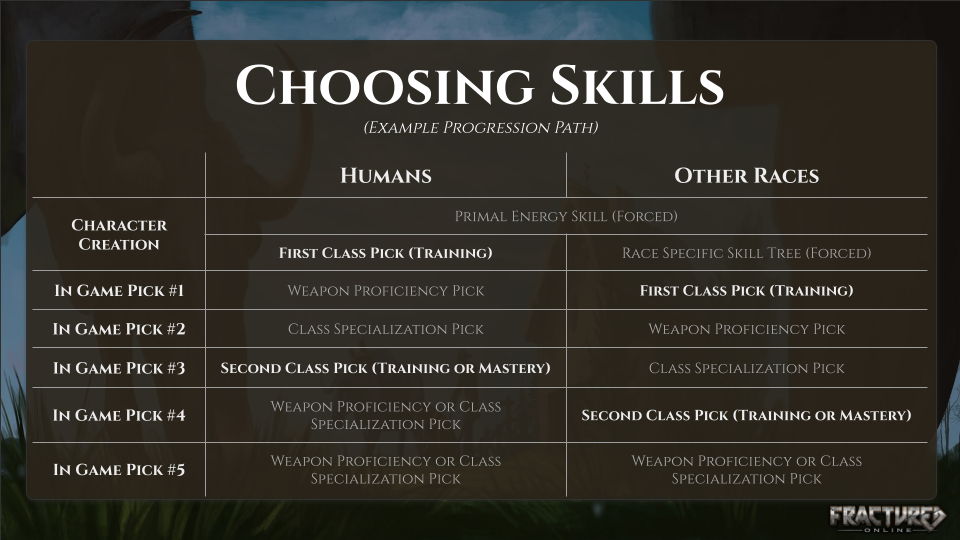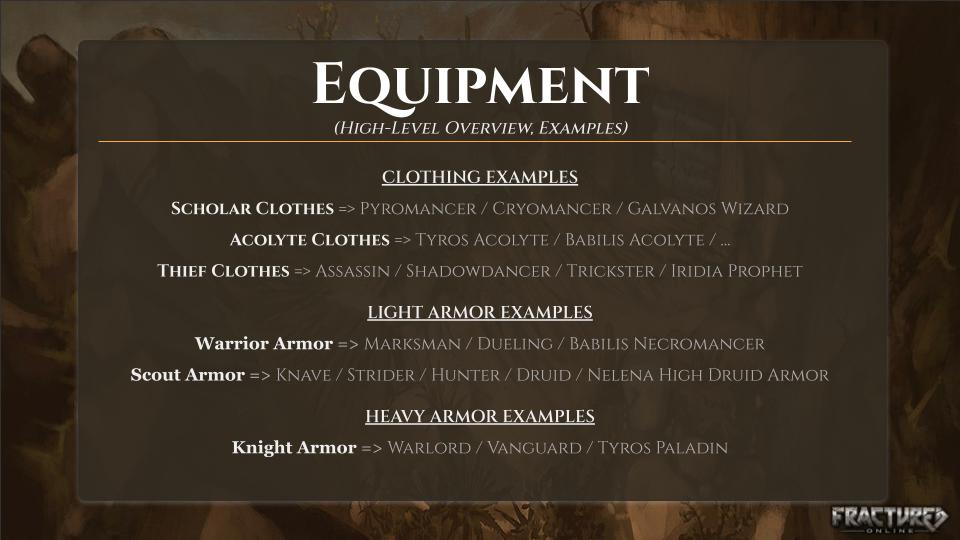Archetypes, Skills, and Equipment Overview
April 26th, 2025 at 3:32 amA breakdown of Fractured Online’s new class system covering archetypes, skills, equipment, and build possibilities from the latest dev livestream.
In case you missed it, our first systems design-focused developer livestream which featured Lead Designer Andrea Tunesi. He walked through the upcoming Fractured Online class system, including new archetypes, specializations, armor, and weapon plans.
Here we will recap and summarize the information shared, thanks for joining us on this incredible journey!
To start a design is the functionality and details of what we plan to build, so lets walk through the latest in our redesign for classes in the new player progression system.
Pillars of The System
At the foundation of our new class system are four guiding principles, pillars that help us stay true to our vision as we evolve and expand gameplay. These are development goals that shape everything from mechanics to visuals.
1. Character Identity
Every choice you make including skills, gear, or specialization should reflect who your character is. We’re focused on enabling distinct and expressive builds that feel personal and meaningful.
2. Visual Fidelity
Your role in combat should be visually readable at a glance. We want your character’s appearance to reflect their abilities and specialization, what you see should give an understanding of your capabilities.
3. Diverse Archetypes
We’re building a system that supports multiple playstyles. Whether you lean into fighters of great strength, arcane magic, or tactical support, there’s a playstyle to fit with.
4. Optionality Within Each Archetype
We’re not locking you into rigid paths. Within each archetype, you’ll find room to explore and test allowing for creative builds and adaptation over time as the meta changes.
Archetypes & Skill Trees
In our class system redesign, archetypes are at the core of how players shape their characters. An archetype isn’t just a fixed class it’s a flexible combination of skill trees you select as your character progresses. This gives you the option to define your playstyle through meaningful choices and time investment.
Each archetype is built by choosing from various skill trees, which grant:
- Permanent Passive Bonuses– Long-lasting stat boosts or traits that define your character’s baseline strength.
- Interchangeable Passive Abilities– Flexible bonuses you can swap to match your current needs or build.
- Interchangeable Active Abilities – Swappable combat skills that adapt with your playstyle.
There are several types of skill trees available:
- Racial Skills – Tied to your character’s race, offering unique traits and flavor.
- Class Skills – Represent the foundational powers of your chosen combat role.
- Specialization Skills – Unlock as you refine your identity and gain mastery in a particular domain.
- Weapon Proficiencies – Improve your effectiveness with specific weapon types and unlock related abilities.
This layered system is designed to support depth, variety, and flexibility ensuring that your character feels truly yours, while still offering room for experimentation and adaptation.
Skill Tree Types
As players build their archetype, they’ll interact with four distinct types of skill trees. Each serves a different purpose in shaping your character’s strengths, identity, and playstyle.
Racial Skills
Racial skill trees bring uniqueness from the background of your characters race. These trees provide utility in and out of combat.
- Interact with primal energy sources
- Feature race-specific abilities and traits
- Favor long cooldown, high impact skills
Class Skills
These trees represent the broad strokes of traditional RPG classes. Think of them as your character’s foundational set of skills.
- Inspired by canonical RPG roles (e.g., Warrior, Mage)
- Act as prerequisites for deeper specialization
- Highly flexible, choose to focus on one or multiclass into other combinations
- Choose to master your class to further reinforce your chosen playstyle (Adept into Mastery progression)
Specialization Skills
Specialization trees are about refinement. These skills are narrower in focus, enabling distinct builds within a broader class.
- Unlocked after selecting a class
- Thematic and less generic
- Dive into specific mechanics (e.g., stealth, summoning)
- Still offer branching choices within a focused theme
Weapon Proficiencies
Your choice of weapon matters more than in the current Fractured Online design. These trees allow mastery over weapon types, unlocking new tactics and combat styles.
- Tied to weapon categories (e.g., swords, staffs, bows)
- Unlock weapon-specific active and passive abilities
- Mechanics-driven trees that reward skillful use
Character Progression Choices
Your path through the class system isn’t bound to one class it’s modular, and varies slightly depending on your race. This table showcases an example skill selection journey for both Humans and Other Races, walking through the different choices you’ll make as you level up and shape your identity.
Planned Skills – Core MVP & Beyond
As we look ahead to the playable foundation of the new class system, here’s a snapshot of our planned skill framework. This proof-of-concept outlines the Core MVP classes and their specializations, with a preview of Core+ content coming later in development.
Core MVP Classes
At launch, we’re focusing on three base classes Fighter, Mage, and Priest each with rich specialization options:
- Fighter
- Warfare, Dueling, Marksmanship, Leadership, Shield Fighting
- Mage
- Pyromancy, Cryomancy, Aeromancy
- Priest
- Of Tyros, Of Babilis, Of Galvanos
Each specialization dives into a unique theme or elemental domain, shaping the active and passive abilities available through their skill trees.
Core+ Expansion
In our post-MVP roadmap unless we can fit these into launch, we’re planning to expand with two additional classes Rogue and Ranger alongside deeper specializations for the Priest:
- Rogue
- Assassination, Shadowdancing, Poisoning, Illusionism
- Ranger
- Marksmanship, Beastmastery, Druidcraft, Poisoning
- Priest (continued)
- Of Iridia
- Of Nelena
These additions allow us to bring in stealth-based gameplay, nature magic, and more diverse builds, which will keep the class system fresh and evolving.
Equipment & Build Customization
As we near the end of this recap, let’s talk about one of the most defining aspects of character expression, equipment. Your gear isn’t just stat-based, it’s a visual and mechanical extension of your archetype.
Equipment follows a tiered system, where progression is tied to both resources and character level. There are three major armor groups:
Gear contributes to archetype fidelity, visual clarity in combat, and unlocks set-based bonuses. Wearing a full set doesn’t just define your look it supports your playstyle.
Endless Build Possibilities
With Core+ in mind, the depth of the system becomes even more exciting:
- 500+ unique archetypes (excluding weapon proficiencies)
- 40,000+ combinations when you factor in weapon proficiencies
- Multiple armor sets, skill trees, and weapon options per archetype
That means hundreds of viable builds—whether you min-max or roleplay, there’s an archetype waiting to be explored.
Thanks for Watching & Reading
That wraps our recap of the class, skill, and equipment system revealed in our latest developer livestream!
We’d love to hear your feedback in the community Discord, and we’ll be back soon with deeper dives into the mechanics.
Latest News
-
7/15 Developer Livestream Recap
July 24th, 2025 at 4:12 am -
6/16 Developer Livestream Recap
June 20th, 2025 at 6:14 am -
06/17 Developer Update Livestream
June 12th, 2025 at 6:24 am -
Community QnA – 6/3/25
June 4th, 2025 at 5:11 am -
Developer Update – Environment Style and Character System
May 29th, 2025 at 11:32 am
